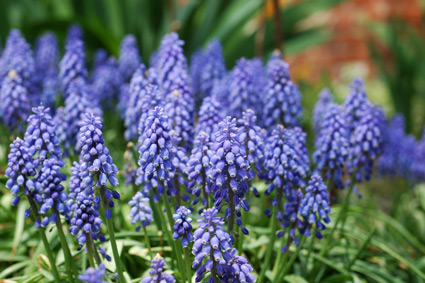
Famous for candy-sweet cobalt blue blooms that resemble tidy clusters of pint-sized grapes, muscari is a versatile, carefree spring bloom. Pack a punch and plant bulbs in eye-catching “rivers” or clustered together in problem areas under trees and in rock gardens. This hardy bulb will even survive in the toxic soil beneath black walnut trees!
Muscari stay in bloom for weeks and multiply effortlessly. Grow white muscari (Muscari botryoides ‘Album’) to use in a spring wedding bouquet or slip a handful of wispy M. comosum ‘Plumosum’ into a vintage medicine bottle. Or better yet, grow my personal favourite M. latifolium whose elongated, bi-colored flower spikes have a dark blue base that ascends to a light blue/lavender top.
———–
With fall bulb planting season in full swing, I couldn’t help posting this little blurb I wrote for the April 2006 issue of Budget Living Magazine that never was. I just love the pretty little delicate blooms of muscari. I have a tendency towards the tiny little bulb plants that naturalize on their own. There is a garden I pass regularly on my travels that is really just a little teeny patch underneath a magnolia tree that comes to life in the spring with an assortment of small flowering bulbs, arranged very carefully for maximum impact as the garden cycles from one flower and is replaced by another. I literally find myself stalking that little garden every spring and was relieved to finally meet one of the owners last year and lay to rest any fears about my weekly presence crouched down with an assortment of cameras in front of their house. They have video surveillance in front!
Thanks so much for the post on muscari bulbs. I have black walnut trees and just recently moved here and not sure what will grow here.
I love these too…someday I’ll get my act together enough in the fall to plant some bulbs…
I too am a super huge fan of these suckers. The M.Latifolium being my faves too. I couldn’t wait for my modest patch to do their naturalizing thing on their own and so doubled up on the bulb action this year supplementing last year’s supply. They were one of the first things to pop up last year and I can’t wait to see them again in Spring.
How pretty! Can you plant them in containers?
After reading about your positive experiences, I’m stumped by my odd-looking hyacinths. They came in this year (I planted them last fall) and I almost didn’t recognize them as hyacinths. Their little blooms were one big clump in most cases, and they were not a bright purple-blue as I expected. Instead, the whole whitish-lavender mass on the end of each stalk looked rather deformed. Any idea why the blooms wouldn’t have separated? Do I have mutant plants?? Thanks…